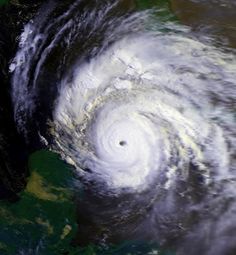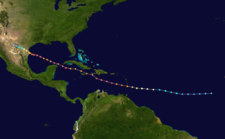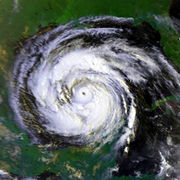Hurricane Allen
| Category 5 hurricane (SSHS) | ||
|---|---|---|
 Hurricane Allen in the Yucatán Channel near peak intensity on August 7, 1980 |
||
| Formed | July 31, 1980 | |
| Dissipated | August 11, 1980 | |
| Highest winds |
|
|
| Lowest pressure | 899 mbar (hPa; 26.55 inHg) | |
| Fatalities | 249 direct[1] | |
| Damage | $1.0015 billion (1980 USD) $2.7 billion (2010 USD) |
|
| Areas affected |
Windward Islands, Haiti, Jamaica, Yucatán Peninsula, northern Mexico, southern Texas | |
| Part of the 1980 Atlantic hurricane season |
||
Hurricane Allen was the first and strongest hurricane of the 1980 Atlantic hurricane season. It was one of the strongest hurricanes in recorded history, one of the few hurricanes to reach Category 5 status on the Saffir-Simpson Hurricane Scale on three separate occasions, and spent more time as a Category 5 than any other Atlantic hurricane. Allen is the second of only two hurricanes in the recorded history of the Atlantic basin to achieve sustained winds of 190 mph (310 km/h), after Hurricane Camille in 1969.
Throughout its life, Allen moved through the deep tropics on a west-northwesterly course through the tropical Atlantic ocean, Caribbean Sea, and Gulf of Mexico before making landfall near the United States/Mexico border. At peak strength, it passed near Haiti, causing hundreds of deaths and heavy damage. After crossing the Gulf of Mexico, Allen weakened as it struck the lower Texas coast, causing high winds, a significant storm surge, and heavy rainfall which caused damage to southern Texas. Overall, Allen killed 249 people and left just over $1 billion in damage (1980 USD), mostly within the United States and Haiti. Due to its impact, the name Allen was retired from the six-year revolving list of Atlantic tropical cyclone names in 1981.
Contents |
Meteorological history

Allen was an early Cape Verde-type hurricane which originated from a tropical wave that previously moved off the African coastline on July 30. The system developed as it moved westward, becoming a tropical depression on August 1. Early on August 2, as the depression moved towards the Caribbean, the system stengthened, becoming the first named storm of the season. Allen moved westward at a quick pace of 15 to 20 knots (28 to 37 km/h), becoming a hurricane on August 2 and a major hurricane on the evening of August 3 as the storm passed south of St. Lucia. Allen continued rapidly intensifying into a Category 5 hurricane during the evening of August 4 while south of Puerto Rico and remained at that intensity for over a day. During this time, Allen attained a central pressure of 911 mbar (26.9 inHg), the lowest pressure on record in the eastern Caribbean sea.[2]
The eye passed between Hispaniola and Jamaica as a Category 4 hurricane. After weakening due to friction with the mountains of Haiti and Jamaica, Allen intensified back to a Category 5 hurricane, retaining this intensity for over a day. The storm moved between Cuba and the Yucatán Peninsula, reaching its minimum pressure of 899 millibars (26.5 inHg) while crossing the Yucatán Channel. During Allen's trek through the Caribbean Sea and the Gulf of Mexico, its center of circulation never crossed over land despite its close passage to various islands in and around the Caribbean sea.[2]
| Most intense Atlantic hurricanes | |||||
|---|---|---|---|---|---|
| Rank | Hurricane | Season | Pressure | ||
| hPa | inHg | ||||
| 1 | Wilma | 2005 | 882 | 26.0 | |
| 2 | Gilbert | 1988 | 888 | 26.2 | |
| 3 | "Labor Day" | 1935 | 892 | 26.3 | |
| 4 | Rita | 2005 | 895 | 26.4 | |
| 5 | Allen | 1980 | 899 | 26.5 | |
| 6 | Katrina | 2005 | 902 | 26.6 | |
| 7 | Camille | 1969 | 905 | 26.7 | |
| Mitch | 1998 | 905 | 26.7 | ||
| Dean | 2007 | 905 | 26.7 | ||
| 10 | "Cuba" | 1924 | 910 | 26.9 | |
| Ivan | 2004 | 910 | 26.9 | ||
| Source: HURDAT[3] | |||||
Allen again weakened to a Category 4 storm due to friction with Mexico, but restrengthened into a Category 5 hurricane for a third time as it moved over the open waters of the Gulf of Mexico, keeping this intensity for nearly a full day and with a pressure drop to 909 mbar (26.8 inHg), the lowest pressure ever recorded in the western Gulf of Mexico. Shortly before landfall, a dry air mass in the western Gulf of Mexico caused the storm to weaken substantially. Allen made landfall north of Brownsville, Texas as a Category 3 storm with maximum sustained winds of 115 mph (185 km/h).[2]
Preparations

As Allen approached the Caribbean sea, gale warnings and a hurricane watch were issued for the islands of Barbados, St. Lucia, St. Vincent, Dominica, Grenada, Martinique, and Guadeloupe during the daylight hours of August 3. Gale warnings were in effect for Antigua from 11 a.m. on August 3 until 11 a.m. on August 4. Hurricane warnings were raised for Barbados, St. Vincent, St. Lucia, Martinique, and Dominica from the early afternoon of August 3 until the late morning of August 4. As Allen moved into the Caribbean sea, hurricane watches were issued for southeastern sections of the Dominican Republic and the southwestern peninsula of Haiti from 11 a.m. on August 4 until the morning of August 5. Gale warnings were then in effect for the southern Dominican Republic from the night of August 4 into the night of August 5, while southern Haiti maintained the warnings from the night of August 4 into the morning of August 5. The hurricane watch was issued for Jamaica during the morning hours of August 5, while hurricane warnings were raised for the southwest peninsula of Haiti from the late morning of August 5 into the morning of August 6.[4] Hurricane warnings went into effect for Jamaica from around noon on August 5 until late in the afternoon of August 6. The Cayman Islands saw hurricane watches issued from the afternoon of August 5 into the morning of August 6 before the watches were upgraded to hurricane warnings from the morning until late afternoon of August 6.[5]

As Allen approached the Gulf of Mexico, hurricane warnings were raised for the northeast Yucatán peninsula of Mexico from the afternoon of August 6 into the morning of August 8. Gale warnings were in effect for the Florida Keys from the evening of August 6 into the early morning of August 8. As Allen approached its final landfall, the northeast Mexican coast and Texas coast were placed under a hurricane watch from the morning of August 8 until the morning of August 9 for Mexico and the afternoon of August 9 for Texas. Hurricane warnings were posted for the Texas coast during the afternoon of August 8, and were lowered north of Freeport, Texas during the afternoon of August 9 and south of Freeport during the afternoon of August 10. Gale warnings and a hurricane watch were issued for the Louisiana coast from Vermilion Bay westward from the afternoon of August 8 into the afternoon of August 9. Hurricane warnings were in effect for northeast Mexico from the early afternoon of August 9 into the late afternoon of August 10. Hurricane warnings were downgraded to gale warnings between High Island, Texas and Freeport, Texas between the late afternoon of August 9 and the late afternoon of August 10. Hurricane watches were dropped for the Louisiana coast during the late afternoon of August 9. Hurricane warnings were downgraded to gale warnings for the lower Texas coast south of Freeport from the late afternoon of August 10 into the early morning of August 11.[5]
Impact
Allen caused just over $1 billion (1980 USD) in damages and killed at least 271 people throughout its course (including indirect deaths).[6][7]
Caribbean islands
| Country | Total deaths |
Direct deaths |
Damage (USD) |
Source |
| Barbados | 0 | 0 | $1.5 million | [6] |
| St. Lucia | 18 | 18 | Severe | [6] |
| Guadeloupe | 1 | 1 | Unknown | [6] |
| Haiti | 220 | 220 | $400 million | [7] |
| Jamaica | 8 | 8 | Unknown | [7] |
| Mexico | 0 | 0 | Minimal | [7] |
| United States | >24 | 2 | $600 million | [7] |
| Totals: | >271 | 249 | ~$1 billion |
In Barbados, preliminary damages were estimated to be $1.5 million (1980 USD). About 500 houses were either damaged or destroyed. No deaths were reported. St. Lucia sustained catastrophic damage from the strong category 3 hurricane. Sustained winds of 90 knots (170 km/h) and a sea level pressure as low as 967 millibars (28.6 inHg) were reported at Hewanorra.[8] Eighteen people lost their lives as a result of the storm's passage. One death in Guadeloupe was attributed to Allen.[6] In Martinique, damage was extensive as the storm passed 50 miles (80 km) south of the island. Waves 6 metres (20 ft) high battered the coast of the island during the storm.[9]
In the central Caribbean, Cayman Brac was hit by winds in excess of 115 mph (185 km/h) which caused considerable property damage. A coral reef at Discover Bay, Jamaica was devastated by the wave action from the storm.[10] Offshore Jamaica, greater numbers of smaller-sized Damselfishes were witnessed in the wake of Allen.[11] Eight deaths in Jamaica were attributed to Allen. Damage was very significant along the northeast coast, where the hurricane made its closest approach to the island and created a 12 metres (39 ft) storm surge. Three deaths were attributed to Allen in Cuba.[7]
Extensive damage occurred in Haiti due to high winds and flash flooding. Total costs for that country were estimated to be at more than $400 million (1980 USD). Roughly 60% of the nation's coffee crop was destroyed. In all, 220 people were killed and 835,000 were left homeless. In Port-au-Prince, 41 deaths were caused by tin roofs flying off and around 1200 were made homeless by flooding.[12]
Mexico
Areas of northeastern Mexico saw heavy rains with the passage of Allen, with the highest totals exceeding 7 inches (180 mm).[13] The hurricane earlier brushed the Yucatán Peninsula. As Allen only affected sparsely populated regions of Mexico, there were no reports of significant damage.[7]
United States

In Texas, the storm surge was reported as high as 12 feet (3.7 m) at Port Mansfield, though it may have been higher elsewhere along the Texas coast. A peak wind gust of 129 mph (208 km/h) was also measured at Port Mansfield. Tropical storm-force winds in Corpus Christi, Texas blew roof gravel through the city, which led to substantial glass breakage to the 18-story Guarantee Bank Building and a 12-story wing of Spohn hospital.[14] The storm caused seven deaths in Texas and 17 in Louisiana (most resulting from the crash of a helicopter evacuating workers from an offshore platform). Allen spawned several tornadoes in Texas. One tornado caused $100 million in damage when it hit Austin, Texas, making it the costliest tropical cyclone-spawned tornado in recorded history. Overall, however, the storm caused limited damage in the United States due to its suddenly diminished power and because its highest tides and winds hit a sparsely-populated portion of the Texas coast.[7]
Allen dumped 10 inches (250 mm) to 20 inches (510 mm) of rain in south Texas, ending a summer-long drought during the Heat Wave of 1980. Its storm total rainfall map is shown to the right.[15]
Retirement
Because of the destruction, extreme death tolls and intensity, the name Allen was retired from the Atlantic tropic storms list in the spring of 1981, and will never be used again for a future Atlantic hurricane.[16] It was replaced with Andrew in the 1986 season.[17]
Records

When Allen reached Category 5 intensity on August 5, it became the earliest Category 5 storm ever recorded. This record stood until Hurricane Emily shattered it on July 16, 2005. Allen is one of three Atlantic hurricanes to reach Category 5 on the Saffir-Simpson hurricane scale on three separate occasions, the others being Hurricane Ivan and Hurricane Isabel. Allen also produced the fifth-lowest minimum pressure ever recorded in the Atlantic basin at 899 mbar (hPa) and was the strongest known hurricane in the basin, in terms of pressure, since 1935. Until then, it was the second strongest hurricane by pressure in the Atlantic Basin, but was since pushed down to fifth, and no hurricane has achieved 190 miles per hour (310 km/h) winds in this basin since then.[18] It remains the most intense storm ever in August. Allen spent nearly 3 days as a Category 5 storm, by far the highest of any Atlantic hurricane.[2] Five typhoons have spent longer as Category 5 storms, including most recently Karen and Nancy in the early 1960s.[19]
See also
- List of tropical cyclones
- List of Atlantic hurricanes
- List of Category 5 Atlantic hurricanes
References
- ↑ Edward N. Rappaport, Jose Fernandez-Partagas, and Jack Beven (1997-04-22). "The Deadliest Atlantic Tropical Cyclones, 1492-1996: Appendix 1. Cyclones with 25+ Deaths". National Hurricane Center. http://www.nhc.noaa.gov/pastdeadlyapp1.shtml. Retrieved 2010-02-21.
- ↑ 2.0 2.1 2.2 2.3 National Hurricane Center (2010-03-06). "North Atlantic Hurricane Database". National Oceanic and Atmospheric Administration. http://www.nhc.noaa.gov/tracks1851to2009_atl_reanal.txt. Retrieved 2010-03-06.
- ↑ Staff Writer (2010-03-01). "Atlantic hurricane best track (Hurdat)". National Hurricane Center. National Oceanic and Atmospheric Administration. http://www.nhc.noaa.gov/tracks1851to2009_atl_reanal.txt. Retrieved 2010-03-20.
- ↑ National Hurricane Center (1980). "Hurricane Allen Tropical Cyclone Report Page 3". National Oceanic and Atmospheric Administration. http://www.nhc.noaa.gov/archive/storm_wallets/atlantic/atl1980-prelim/allen/prelim03.gif. Retrieved 2010-02-16.
- ↑ 5.0 5.1 National Hurricane Center (1980). "Hurricane Allen Tropical Cyclone Report Page 4". National Oceanic and Atmospheric Administration. http://www.nhc.noaa.gov/archive/storm_wallets/atlantic/atl1980-prelim/allen/prelim04.gif. Retrieved 2010-02-16.
- ↑ 6.0 6.1 6.2 6.3 6.4 National Hurricane Center. "Hurricane Allen Tropical Cyclone Report Page 5". National Oceanic and Atmospheric Administration. http://www.nhc.noaa.gov/archive/storm_wallets/atlantic/atl1980-prelim/allen/prelim05.gif. Retrieved 2008-12-14.
- ↑ 7.0 7.1 7.2 7.3 7.4 7.5 7.6 7.7 National Hurricane Center. "Hurricane Allen Tropical Cyclone Report Page 6". National Oceanic and Atmospheric Administration. http://www.nhc.noaa.gov/archive/storm_wallets/atlantic/atl1980-prelim/allen/prelim06.gif. Retrieved 2008-12-14.
- ↑ Miles B. Lawrence and Joseph M. Pellisier (July 1981). Atlantic Hurricane Season of 1980. 109. American Meteorological Society. p. 1572. http://www.aoml.noaa.gov/general/lib/lib1/nhclib/mwreviews/1980.pdf. Retrieved 2010-02-17.
- ↑ K. Bosser, F. Levoy, J. C. Flageollet, O. Monfort, and H. Rousset (Summer 2000). "Trade Wind Intensification and Hurricanes on a Caribbean Beach, Martinique Island: A Comparison of their Morphological Effects From Field Experiments and Numerical Simulations" (Subscription required). Journal of Coastal Research (Coastal Education & Research Foundation, Inc.) 15 (3): 877–899. http://www.jstor.org/pss/4300098. Retrieved 2010-02-17.
- ↑ Richard B. Aronson, Kenneth P. Sebens, and John P. Ebersole (2003). "Hurricane Hugo's Impact on Salt River Submarine Canyon, St. Croix, U.S. Virgin Islands". Atlantic Oceanographic and Meteorological Laboratory. http://www.aoml.noaa.gov/general/lib/CREWS/Cleo/St.%20Croix/salt_river46.pdf. Retrieved 2010-02-16.
- ↑ Robert K. Turpin and Stephen A. Bortone (2002). "Pre- and post-hurricane assessment of artificial reefs: evidence for potential use as refugia in a fishery management strategy". ICES Journal of Marine Science 59: S75. doi:10.1006/jmsc.2002.1191. http://icesjms.oxfordjournals.org/cgi/reprint/59/suppl/S74.pdf.
- ↑ Jim Williams (2010). Port au prince,Haiti's history with tropical systems. Hurricanecity.com. Retrieved on 2010-02-17.
- ↑ David M. Roth (2007-01-15). "Storm Total Rainfall From Hurricane Allen (1980)". Hydrometeorological Prediction Center. http://www.hpc.ncep.noaa.gov/tropical/rain/allen1980filledrainblk.gif. Retrieved 2010-02-16.
- ↑ Joseph E. Minor, P.E., William L. Beason, and Timothy P. Marshall (1981). "Effects of Hurricane Allen on Buildings and Coastal Construction". Fourth National Conference on Wind Engineering Research. http://www.depts.ttu.edu/weweb/Pubs/pdfs/D8-10-80%20Hurr%20Allen.pdf. Retrieved 2010-02-16.
- ↑ David M. Roth (2007-01-27). "Hurricane Allen". Hydrometeorological Prediction Center. http://www.hpc.ncep.noaa.gov/tropical/rain/allen1980.html. Retrieved 2010-02-16.
- ↑ National Hurricane Center (2009). "Retired Hurricane Names Since 1954". National Oceanic and Atmospheric Administration. http://www.nhc.noaa.gov/retirednames.shtml. Retrieved 2009-09-13.
- ↑ Staff Writer (1986-05-23). "Andrew, Agatha, top 1986 list". Gadsden Times. Google News Archive. http://news.google.co.uk/newspapers?id=SLkfAAAAIBAJ&sjid=Z9cEAAAAIBAJ&dq=hurricane%20names&pg=2345%2C6380696. Retrieved 2009-12-23.
- ↑ United States Department of Commerce (June 2006). "Hurricane Katrina Service Assessment". National Oceanic and Atmospheric Administration. http://www.weather.gov/om/assessments/pdfs/Katrina.pdf. Retrieved 2007-04-13.
- ↑ Neal Dorst (2004-08-13). "Subject: E8) What hurricanes have been at Category Five status the longest?". National Hurricane Center. http://www.aoml.noaa.gov/hrd/tcfaq/E8.html. Retrieved 2010-02-17.
Further reading
- Marks, Frank D. (1985). "Evolution of the Structure of Precipitation in Hurricane Allen (1980)". Monthly Weather Review 113 (6): 909–930. doi:10.1175/1520-0493(1985)113<0909:EOTSOP>2.0.CO;2.
External links
- National Weather Service - Hurricane Allen
- The Wake of Hurricane Allen in the Western Gulf of Mexico
- Effects of Hurricane Allen on Buildings and Coastal Construction
- Pertinent Meteorological Data for Hurricane Allen of 1980
|
||||||||||||||||||||
|
||||||||||||||||||||||||||
|
|
||||||||||||||||||||||||||||||